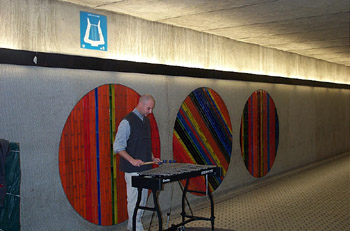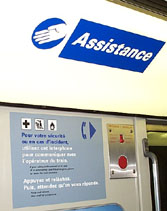- WHAT ARE THE RULES FOR METRO PASSENGERS?
Click on this link for a complete listing of the rules for metro passengers.
TOP OF THIS PAGE | FAQ CONTENTS
- WHERE CAN I GO TO GET INFORMATION ON THE SYSTEM, REPORT AN INCIDENT, OR FIND A LOST ITEM?
The STM's customer service centre is the Station-Service Berri-UQAM, located at the mezzanine level of metro Berri-UQAM. It includes a security office, lost and found, customer service office, ticket booths selling all transport passes year-round, and stands dispensing bus schedules for every route.
TOP OF THIS PAGE | FAQ CONTENTS

- HOW ARE MUSICIANS PERMITTED TO PLAY IN THE METRO?
Musicians are permitted to play in certain defined areas, marked with a lyre symbol, between the hours of 6 am to 11 pm in most locations. They must sign up with their fellow musicians, and are not allowed to exceed 80 decibels.
TOP OF THIS PAGE | FAQ CONTENTS
- HAS THERE EVER BEEN A COLLISION IN THE MONTREAL METRO?
Only once. On 9 December 1971, a train operator was killed when a metro car crashed and caught fire at Henri-Bourassa metro. The fire destroyed a garage and 27 trains, totalling about $7 million in damage. See the next question for more information.
TOP OF THIS PAGE | FAQ CONTENTS
- HAS THERE EVER BEEN A FIRE IN THE MONTREAL METRO?
Only two major fires have ever occurred in the metro's 35 years of service; no passengers have ever been injured.
In addition to the collision mentioned above, there has been only one other major incident. On 23 January 1974, a series of tire blowouts caused a fire which destroyed a nine-car train between metro Laurier and Rosemont. Thousands of commuters were evacuated through smoke-filled tunnels. Nobody was injured. A subsequent inquiry recommended about $70 million worth of changes.
Since then, only a few minor incidents have taken place. On 14 July 1990 and 19 January 1992, fires in garbage cans shut down major parts of the system for an hour each. On 26 May 1993, an underground cable overheated between Jolicoeur and Verdun metro, causing smoke to billow through the tunnel.
All of the materials in the rolling stock and installations are non-flammable, even the plastic seats. The system is also equipped with ventilators that can blow and draw the smoke away from passengers in case of fire, as well as state-of-the-art fire suppression equipment. The STM employs 12 fire-prevention specialists and maintains a fire preparedness centre near Henri-Bourassa metro. The central computer at the Providence Centre is programmed with 2500 possible fire scenarios and can recommend an evacuation direction and ventilation measures within 45 seconds. As a result of these measures, no passenger has ever been injured due to a fire or collision in the metro. Montreal's metro has in fact been honoured by the American Public Transit Association (APTA) as one of the safest subway systems in the world.
TOP OF THIS PAGE | FAQ CONTENTS
- WHAT SHOULD I DO IN CASE OF AN EMERGENCY?
If your or someone else's safety is threatened on a metro platform, find one of the assistance points, indicated with a lighted blue panel with a hand symbol. These stations include a telephone to communicate with STM personnel; a fire extinguisher; and a handle to cut the power to the rails.
If an incident occurs in a train, there are intercoms which permit you to communicate with the driver, as well as an emergency brake which stops the train in the station it's in or in the next station.
If it becomes necessary to evacuate the train, follow the instructions of STM personnel.
Misuse of emergency equipment is against the law and can lead to severe fines.
TOP OF THIS PAGE | FAQ CONTENTS
- DO PEOPLE EVER COMMIT SUICIDE IN THE METRO?
Between 1986 and 1995, some 115 people killed themselves in the metro. There were also 323 suicide attempts and 362 suicidal people apprehended by metro personnel before they attempted suicide. Although STM intervention has decreased the number of suicides and attempts, metro suicide is a tragic problem not only for the troubled individuals and their friends and families, but also for the bystanders and STM personnel. Traumatic effects on metro drivers are particularly well documented.
If you see someone who shows one of these warning signs:
- appears distressed;
- hesitates on the platform;
- does not take the first available train,
please alert STM personnel by using a telephone at one of the security stations on the platform. Security officers will be dispatched and trains will be put on manual control before entering the station. You don't have to get directly involved and you may save a life.
If you or someone you love is thinking of committing suicide, please click on one of these links:
TOP OF THIS PAGE | FAQ CONTENTS
- IS IT PERMITTED TO TAKE PHOTOGRAPHS IN THE METRO?
The STM allows pictures to be taken in the metro, but only under certain conditions. Anyone with a specific project must first contact the Public Affairs department by either calling 514 280-4941 or faxing their request to 514 280-5658.
Please note that behaviour that could hinder passengers' movement is prohibited.
TOP OF THIS PAGE | FAQ CONTENTS








